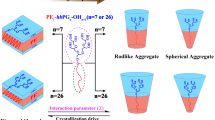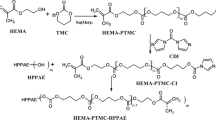Abstract
In this article, we reported the solution self-assembly of a series of amphiphilic linear-block-hyperbranched copolymers, which are composed of linear polyethylene (PE) blocks and hyperbranched poly(glycidol) (hbPG) blocks with 100% hydroxyl terminals (PE157-b-hbPG26-OH27, E1), partially acetyl terminals (PE157-b-hbPG26-acetyl≈50%, E2) and fully acetyl terminals (PE157-b-hbPG26-acetyl≈100%, E3) respectively. In the selective solvent of PE blocks, the epitaxial growth characteristics of crystalline PE conferred the ability of block copolymer (E1) to generate perfect two-dimensional lamellar structure. Fully hydroxyl acylation will reinforce the repulsion of the lamellar surface and interfere with the epitaxial growth of lamellae, forming an imperfect lamellar structure (E3). For E2, the hydrogen bonds formed between hydroxyl and carbonyl oxygen prevented the unimers from approaching the growth interface of lamellae, forming a disordered lamellar structure. In the selective solvent for hbPG block, the solvent induced the copolymers to self-assemble into spherical (E1 and E2) and wormlike (E3) primary micelles. Furthermore, the spherical and wormlike primary micelles were assembled at higher level into more stable spherical (E1), rod-shaped (E2) and spindle-shaped (E3) aggregates. Mechanisms of terminal acylation on the morphology of self-assembly in block-selective solutions were proposed.








Similar content being viewed by others
References
Schacher FH, Rupar PA, Manners I (2012) Functional Block Copolymers: Nanostructured Materials with Emerging Applications. Angew Chem Int Ed 51(32):7898–7921
Li F, Yang LL, Xu G, Hydrothermal J (2013) Self-assembly of hierarchical flower-like ZnO nanospheres with nanosheets and their application in Li-ion batteries. Alloy Compd 577:663–668
O’Reilly RK (2007) Spherical polymer micelles: nanosized reaction vessels? Phil Trans R Soc A 365(1861):2863–2878
Savic R, Luo LB, Eisenberg A, Maysinger D (2003) Micellar nanocontainers distribute to defined cytoplasmic organelles. Science 300(5619):615–618
Hamley IW (2003) Nanotechnology with soft materials. Angew Chem Int Ed 42(15):1692–1712
Simonyan A, Gitsov I (2008) Linear-dendritic supramolecular complexes as nanoscale reaction vessels for “green” chemistry. Diels− Alder reactions between fullerene C60 and polycyclic aromatic hydrocarbons in aqueous medium. Langmuir 24(20):11431–11441
Nishiyama N, Kataoka K (2006) Current state, achievements, and future prospects of polymeric micelles as nanocarriers for drug and gene delivery. Pharmacol Ther 112(3):630–648
Gillies ER, Fréchet JMJ (2002) Designing macromolecules for therapeutic applications: polyester dendrimer poly (ethylene oxide)“bow-tie” hybrids with tunable molecular weight and architecture. J Am Chem Soc 124(47):14137–14146
Lim Y, Moon KS, Lee M (2008) Rod–coil block molecules: their aqueous self-assembly and biomaterials applications. J Mater Chem 18(25):2909–2918
Miao Y, Niu X, Wu A, Wu M, Jin S (2021) Metallic oxide-induced self-assembly of block copolymers to form polymeric hybrid micelles with tunable stability for tumor microenvironment-responsive drug delivery. ACS Appl Mater Interfaces 13(28):32753–32762
Lopresti C, Lomas H, Massignani M, Smart T, Battaglia G (2009) Polymersomes:nature inspired nanometer sized compartments. J Mater Chem 19(22):3576–3590
Xu JT, Fairclough JPA, Mai SM, Ryan AJ (2003) The effect of architecture on the morphology and crystallization of oxyethylene/oxybutylene block copolymers from micelles in n-hexane. J Mater Chem 13(11):2740–2748
Besenius P (2017) Controlling supramolecular polymerization through multicomponent self-assembly. Sci Part A Polym Chem 55(1):34–78
Terreau O, Bartels C, Eisenberg A (2004) Effect of poly (acrylic acid) block length distribution on polystyrene-b-poly (acrylic acid) block copolymer aggregates in solution. 2. A partial phase diagram. Langmuir 20(3):637–645
Hailes RLN, Oliver AM, Gwyther J, Manners I, Whittell GR (2016) Polyferrocenylsilanes: synthesis, properties, and applications. Chem Soc Rev 45(19):5358–5407
Azzam T, Eisenberg A (2006) Control of vesicular morphologies through hydrophobic block length. Angew Chem Int Ed 45(44):7443–7447
Legros C, Pauw-Gillet MCD, Tam KC, Taton D (2015) Crystallisation-driven self-assembly of poly (2-isopropyl-2-oxazoline)-block-poly (2-methyl-2-oxazoline) above the LCST. Soft Matter 11(17):3354–3359
Sun L, Petzetakis N, Barry AP, O’Reilly RK, Dove AP (2013) Tuning the size of cylindrical micelles from poly (L-lactide)-b-poly (acrylic acid) diblock copolymers based on crystallization-driven self-assembly. Macromolecules 46(22):9074–9082
Gädt T, Sleong N, Cambridge G, Winnik MA, Manners I (2009) Complex and hierarchical micelle architectures from diblock copolymers using living, crystallization-driven polymerizations. Nat Mater 8(2):144–150
Lotz B, Kovacs AJ, Bassett GA, Keller A (1966) Properties of copolymers composed of one poly-ethylene-oxide and one polystyrene block. Soft Matter 209(2):115–128
Qiu H, Gao Y, Du VA, Harniman R, Winnik MA, Manners I (2015) Branched micelles by living crystallization-driven block copolymer self-assembly under kinetic control. J Am Chem Soc 137(6):2375–2385
Nakagawa S, Kadena K, Ishizone T (2012) Crystallization behavior and crystal orientation of poly (ε-caprolactone) homopolymers confined in nanocylinders: Effects of nanocylinder dimension. Macromolecules 45(4):1892–1900
Lin EK, Gast AP (1966) Semicrystalline diblock copolymer platelets in dilute solution. Macromolecules 29(12):4432–4441
Müller AJ, Balsamo V, Arnal ML (2005) Nucleation and crystallization in diblock and triblock copolymers. Adv Polym Sci 190:1–63
Schmarsow RN, Ceolín M, Zucchi IA, Schroeder WF (2019) Core-crystalline nanoribbons of controlled length via diffusion-limited colloid aggregation. Soft Matter 15(23):4751–4760
Fan B, Liu L, Li JH, Xu JT (2016) Crystallization-driven one-dimensional self-assembly of polyethylene-b-poly (tert-butylacrylate) diblock copolymers in DMF: effects of crystallization temperature and the corona-forming block. Soft Matter 12(1):67–76
Cheng SW, Hu Y, Wu XH, Mu JS (2021) Hierarchical Self-Assembly of Polyethylene Midblock Copolymers in Hot Steam: Key Role of Crystalline and Topological Structure. Macromol Chem Phys 7:2000419
Cambridge G, Guerin G, Manners I, Winnik MA (2021) Fiberlike micelles formed by living epitaxial growth from blends of polyferrocenylsilane block copolymers. Macromol Rapid Commun 31(9–10):934–938
Kynaston EL, Gould OEC, Gwyther J, Whittell GR, Manners I, Winnik MA (2015) Fiber-Like Micelles from the Crystallization-Driven Self-Assembly of Poly (3-heptylselenophene)-block-Polystyrene. Macromol Chem Phys 216(6):685–695
Gilroy JB, Lunn DJ, Patra SK, Manners I, Winnik MA (2015) Fiber-like micelles via the crystallization-driven solution self-assembly of poly (3-hexylthiophene)-block-poly (methyl methacrylate) copolymers. Macromolecules 45(14):5806–5815
Mihut AM, Drechsler M, Möller M, Ballauff M (2010) Sphere-to-rod transition of micelles formed by the semicrystalline polybutadiene-block-poly (ethylene oxide) block copolymer in a selective solvent. Macromol Rapid Commun 31(5):449–453
Sun L, Barry AP, Kirby N, Schiller TL, Sanchez AM, Dyson MA, Wilson NR, O’Reilly RK, Dove AP (2014) Aggregation and morphology control enables multiple cases of high-efficiency polymer solar cells. Nat Commun 5(1):1–8
Cheng H, Wang S, Yang J, Zhou Y, Yan D (2009) Synthesis and self-assembly of amphiphilic hyperbranched polyglycerols modified with palmitoyl chloride. J Colloid Interface Sci 337(1):278–284
Deng Z, Liu S (2020) Emerging trends in solution self-assembly of block copolymers. Polymer 207:122914
Lu Y, Lin J, Wang L, Zhang L, Cai C (2020) Self-assembly of copolymer micelles:higher-level assembly for constructing hierarchical structure. Chem Rev 120(9):4111–4140
Loo YL, Register RA, Ryan AJ (2000) Polymer crystallization in 25-nm spheres. Phys Rev Lett 84(18):4120
Droghetti H, Pagonabarraga I, Carbone P, Asinari P, Marchisio D (2018) Dissipative particle dynamics simulations of tri-block co-polymer and water: Phase diagram validation and microstructure identification. J Chem Phys 149(18):184903
Wang XY, Wang RY, Fan B, Du BY, Fan ZQ (2018) Specific disassembly of lamellar crystalline micelles of block copolymer into cylinders. Macromolecules 51(5):2138–2144
Gao C, Yan D (2004) Hyperbranched polymers: from synthesis to applications. Prog Polym Sci 29(3):183–275
Zhou Y, Yan D (2009) Supramolecular self-assembly of amphiphilic hyperbranched polymers at all scales and dimensions:progress, characteristics and perspectives. Chem Commun 10:1172–1188
Voit B (2000) New developments in hyperbranched polymers. J Polym Sci Part A: Polym Chem 38(14):2505–2525
Grzelakowski M, Tokarczyk KK (2016) Terminal groups control self-assembly of amphiphilic block copolymers in solution. Nanoscale 8(12):6674–6683
Zhu J, Yu H, Jiang W (2005) Morphological transition of aggregates from ABA amphiphilic triblock copolymer induced by hydrogen bonding. Macromolecules 38(17):7492–7501
Li X, Gao Y, Harniman R, Manners I, Winnik MA (2016) Hierarchical assembly of cylindrical block comicelles mediated by spatially confined hydrogen-bonding interactions. J Am Chem Soc 138(39):12902–12912
Yang JX, Fan B, Li JH, Xu JT, Fan ZQ (2016) Hydrogen-bonding-mediated fragmentation and reversible self-assembly of crystalline micelles of block copolymer. Macromolecules 49(1):367–372
Zhou Y, Huang W, Liu J, Yan D, Zhu X (2010) Self-assembly of hyperbranched polymers and its biomedical applications. Adv Mater 22(41):4567–4590
Xiao W, An Z (2019) New Insights into RAFT Dispersion Polymerization-Induced Self-Assembly: From Monomer Library, Morphological Control, and Stability to Driving Forces. Macromol Rapid Commun 40(2):1800325
Barrio JD, Oriol L, Sanchez C, Serrano JL, Cicco AD, Keller P (2010) Self-assembly of linear− dendritic diblock copolymers: from nanofibers to polymersomes. J Am Chem Soc 132(11):3762–3769
Yan D, Zhou Y, Hou J (2004) Supramolecular self-assembly of macroscopic tubes. Science 303(5654):65–67
Liu X, Gitsov I (2019) Nonionic amphiphilic linear dendritic block copolymers. solvent-induced self-Assembly and morphology tuning. Macromolecules 52(15):5563–5573
Liu ZS, Yang F, Wu XH, Li W, Gong DR, Mu JS (2016) Polyethylene-block-hyperbranched polyglycerol diblock copolymers: synthesis, thermal property and compatibilization. J Polym Res 23(8):1–9
Ding LF, Qian JY, Zhu GJ, Mu JS (2019) Self-assembly of linear-hyperbranched hybrid block polymers: crystallization-driven or solvent-driven? J Polym Res 26(5):1–8
Miller-Chou BA, Koenig JL (2003) A review of polymer dissolution. Prog Polym Sci 28(8):1223–1270
Acknowledgements
The Bio-ultrastructure Analysis Laboratory of the Key Laboratory of Applied Marine Biotech- nology of the Ministry of Education, Ningbo University provides assistance with testing equipments.
Funding
The project of the Natural Science Foundation of Ningbo (2019A610149).
Author information
Authors and Affiliations
Corresponding author
Ethics declarations
Conflict of interests
The authors declare that they have no known competing financial interests or personal relationships that could have appeared to influence the work reported in this paper.
Additional information
Publisher's Note
Springer Nature remains neutral with regard to jurisdictional claims in published maps and institutional affiliations.
Supplementary information
Below is the link to the electronic supplementary material.
Rights and permissions
About this article
Cite this article
Hu, Y., Mu, J. How the modification of the hyperbranched terminals affects the solution self-assembly of linear-block-hyperbranched copolymers. J Polym Res 29, 229 (2022). https://doi.org/10.1007/s10965-022-03088-1
Received:
Accepted:
Published:
DOI: https://doi.org/10.1007/s10965-022-03088-1




